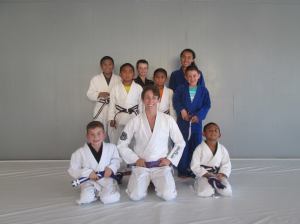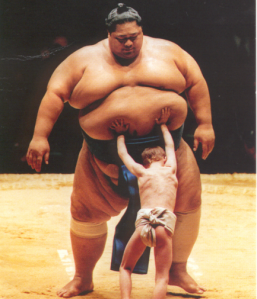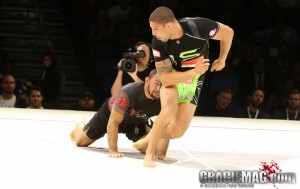Category Archives: Self-Defense
Train Like a Kid
As I was teaching our FVGC Advanced kids jiu-jitsu class the other day, I looked around the room as the kids were drilling technique and felt proud! It was a class of 6-12 year olds repping their techniques with beautiful movement and great discipline. They hardly needed any tries to “get it right”. During rolling they stayed controlled and calm, hardly ever relying on size or strength to gain position or get the submission. It occurred to me in that moment that in some ways it was easier to teach this class than the adult white belts, that the adults have a harder time smoothly doing technique and rolling with some flow.
 How is this possible? Here are 3 reasons I came up with:
How is this possible? Here are 3 reasons I came up with:
- Kids come in with little to no pre-conceived ideas about BJJ: Usually kids come into class not knowing what jiu-jitsu is or how it should look. So, they come into class and take the instructor’s word for how things should be done and mimic the body movements and style of those that know more than they do. They don’t over-think it; they just DO IT.
- They work with adult instructors: The first time our kids roll, it is with an adult that is much larger than they are; perhaps this gives them the idea that their size and strength cannot be relied on all the time. They are forced to use good technique, as an instructor won’t let them get away with anything else!
- They keep it fun! Ego is much less of a problem in the kids’ classes. Of course, there is always some healthy competition, but the kids take it to heart when an instructor says, “You are going to have bad days rolling. It is okay. It happens to everyone. Everyone makes mistakes, and that is why you keep coming to class”. Even a child that has a rough practice is over it in about 10 minutes and ready to come back for their next class.
So I guess my advice is….Train like a kid! Come to class like a sponge, ready to absorb; roll with people that are bigger or more experienced than you; and, don’t let your ego get in the way of your training. Open your mind, open your heart, and LOVE JIU-JITSU!
Happy Training! 🙂
The Jiu Jitsu Body
I spend a lot of time at the gym both watching and participating in Jiu jitsu classes here in Appleton. During these times, I hear a lot of discussion regarding body type and jiu jitsu. Even the kids in our BJJ program have realized that body type makes a huge difference. Many times the discussion is more of a complaint than anything…
 “My legs are too long to fit the hook in”
“My legs are too long to fit the hook in”
“I am not strong enough to bump him”
“I am not flexible enough for this move”
“I can’t lock my guard/touch my knees to the floor in mount”
And then, there is the speculation that “That guy has the perfect jiu-jitsu body!”
The fact of the matter is that there is no such thing as a perfect jiu-jitsu body. Every body type has its advantages. Tall and lean is great for the guard. They may not be big and strong, but small guys can ball up, move fast and fluidly, and take advantage of little spaces. Those that aren’t that naturally flexible tend to take up a strong pressure and passing games. You must use what nature gave you and work with it! Not every move shown in class is going to be perfect for your game or be your #1 move; we all pick and choose. If you like to watch jiu jitsu videos, it may be a good idea to find someone that shares your body type!
That being said, remember that if you are frustrated with a certain technique or training partner, your body type may not be to blame! You may be missing details, a frame here or a hip movement there, or may need to modify your strategy…it’s probably something that your instructor can help you with!
Intention: Metamoris and the Problem with the BJJ Community
After watching Metamoris II this weekend, I have come to the conclusion that the Brazilian jiu-jitsu community has a problem determining intention.
The Metamoris tournament series was created in part to combat the disturbing growth of jiu jitsu fighters not only winning by points or advantages, but aiming to win in that manner without truly attacking or gaining dominant position. The Metamoris tournament was an attempt to force fighters to move, attack, work diligently for the submission, and not be afraid to get put onto their butt for a moment or two. It seems to be part of the backlash against the 50/50 and other stalling open guard games in the competitive jiu-jitsu community (Yes, this shirt exists). The Metamoris tournament seems to also be an answer the “Self-Defense Jiu jitsu” community, which has criticized IBJJF-style jiu-jitsu for getting away from the so-called true nature and root of BJJ.
Enter Brandon Schaub and Ryron Gracie, representatives of the Gracie Academy and the self-defense BJJ community. In their fights, they both were the less dominant fighters, with Ryron coming to a draw (no submission by Galvao) and Schaub losing (decision, different rules in Metamoris II). And yet, post-fight interviews found them arrogant and declaring their fights
a success based on what their own objective was, which seems to be simply neutralizing their opponent, rather than controlling and submitting. I don’t think that there is anything wrong with training BJJ strictly for self-defense. But, we also need to remember that self-defense jiu-jitsu does not translate into a tournament format: The objective is to extract yourself from a dangerous situation (and yes, you should run if you can). Self-defense jiu-jitsu is not better than competitive BJJ and vice versa; the INTENTION IS DIFFERENT.
In my opinion it is poor sportsmanship and just poor taste to declare victory based on a strategy that isn’t congruent with the rules and objective of the tournament, just like it is in poor taste (and logic) to declare that a competition–driven fighter would not be able to defend themselves or declare that the 50/50 guard is a good way to end a street fight safely. In the end, it seems to be about politics and marketing. Let’s not go down that road. Jiu-jitsu is beautiful; let’s keep it that way.
Combating our Panic: Training for Self-Defense and Competition in Jiu-jitsu
The other day I was teaching beginner Brazilian jiu jitsu in our Appleton school. It is a class in which we have a somewhat wide variety of experience levels, especially when you consider what 3 months of classes does for someone just starting out. So, when it comes to open rolling for the class, I keep a careful eye on all the matches for everyone’s safety and to coach the newbies a little bit. When I looked over I saw one of my 140lb. white belt girls battling with a grown man outweighing her by 60lbs and with at least a year of experience on her. She was on the bottom in side mount and then mount, struggling to escape. The guy she was rolling wasn’t being too rough or a jerk, he was just big and holding decent position. She was fighting, fighting, fighting. All of a sudden, her face changed. I could see the frustration and beginning of tears. She got overwhelmed and lost her will and focus; she made mistakes and was submitted.
It is one thing to get your butt kicked in jiu jitsu, to feel like you fought the good fight, to feel like you were just outclassed by your friend that day … but feeling overwhelmed by someone’s size, strength or experience can steal the heart out of your chest. THIS IS HUGE! It is an important thing to pay attention to whether you are in Gracie jiu-jitsu for self-defense or competition because being overwhelmed leads to PANIC. When we panic, we lose our heads, lose our focus, lose our strategy, lose our technique, and lose the fight.
How do we combat the panic we may feel during live roll? We can do it the same way we can combat any other fear, whether it is a fear of competing, a fear of heights, a fear of public speaking, etc. We practice! We immerse ourselves in the situation until it is no big deal…We compete once per month, we climb a rock wall on a regular basis, we do a presentation or announcement in front of our peers every week at work. When we are used to being in what we perceive as a bad situation, our brains and bodies kick in and do the work to protect us, just as they have practiced 1,000 times. So, we need to roll live and put ourselves in tight spots on a regular basis so we feel good while we roll in practice, so we stay calm when we compete, so we don’t panic when someone grabs us and we need to seriously defend ourselves on the street.
Happy rolling.

